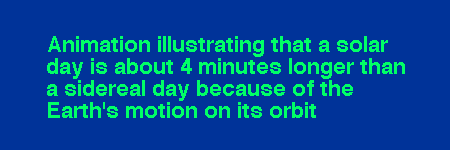 |
| The sidereal and solar day |
Historically, the regular motion of objects in the sky served as the basis for timekeeping. The diurnal motion of the sky caused by the rotation of the Earth on its axis defined the day, the year was defined by the motion of the Earth on its orbit about the Sun, and the month was defined in relation to the revolution of the Moon about the Earth. Although precise modern timekeeping is done electronically, many of the details and the terminology of timekeeping remain rooted in its astronomical heritage.
Technically, the sidereal time is defined as the length of time since the
vernal equinox has crossed the local celestial meridian. An equivalent
definition of the sidereal time is the right ascension of any star presently
located on the local celestial meridian. Thus, if the star Sirius is presently
on your celestial meridian, the sidereal time is 6 hours and 45 minutes because
we saw earlier that Sirius is located at 6 hr 45 min right ascension on the
celestial sphere.
Generally our everyday (civil) time is referenced to the (average)
motion of the Sun, not
the vernal equinox. Thus, sidereal time generally does not coincide with the
everyday (wall clock) time. To be precise, the sidereal time agrees with the
solar time only at the autumnal equinox; at any other time, they differ
(they are exactly 12 hours apart at the time of the vernal equinox).
Sidereal Days and Solar Days
The sidereal day is defined to be the length of time for the
vernal equinox to return to your celestial meridian. The solar day is
defined to be the length of time for the Sun to return to your celestial
meridian. The two are not the same, as illustrated in
the following animation.
 |
| The sidereal and solar day |
Because the Earth is in motion on its orbit around the Sun in the course of a day, the Earth must turn about 4 minutes longer each day (3 minutes and 56 seconds, to be exact) to bring the Sun back to the celestial meridian than to bring the vernal equinox back to the celestial meridian. Thus, the solar day is 3 minutes and 56 seconds longer than the sidereal day. It is this almost 4 minute per day discrepancy that causes the difference in sidereal and solar time, and is responsible for the fact that different constellations are everhead at a given time of day during the Summer than in the Winter.